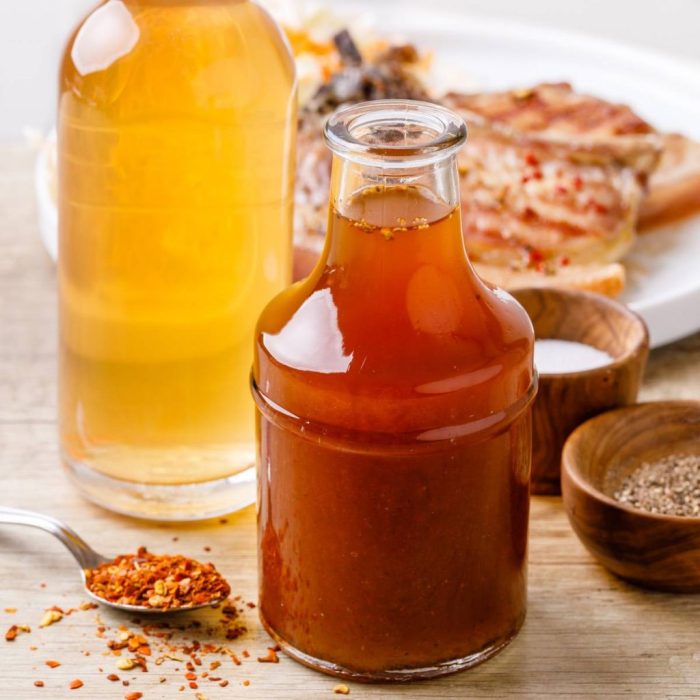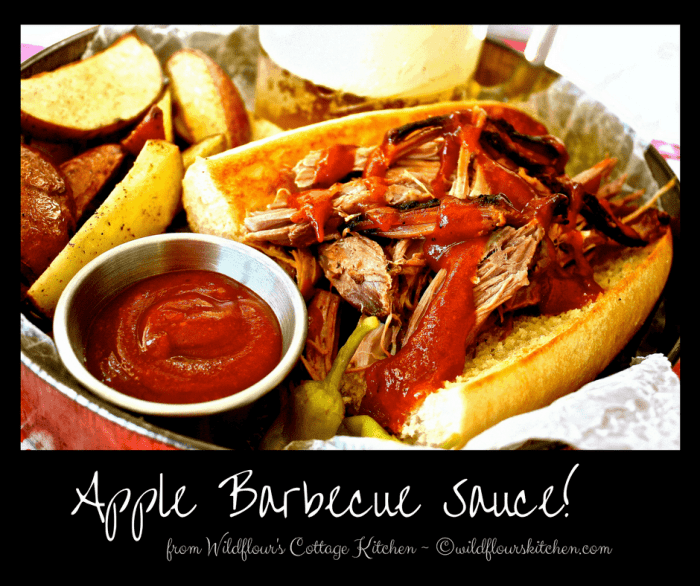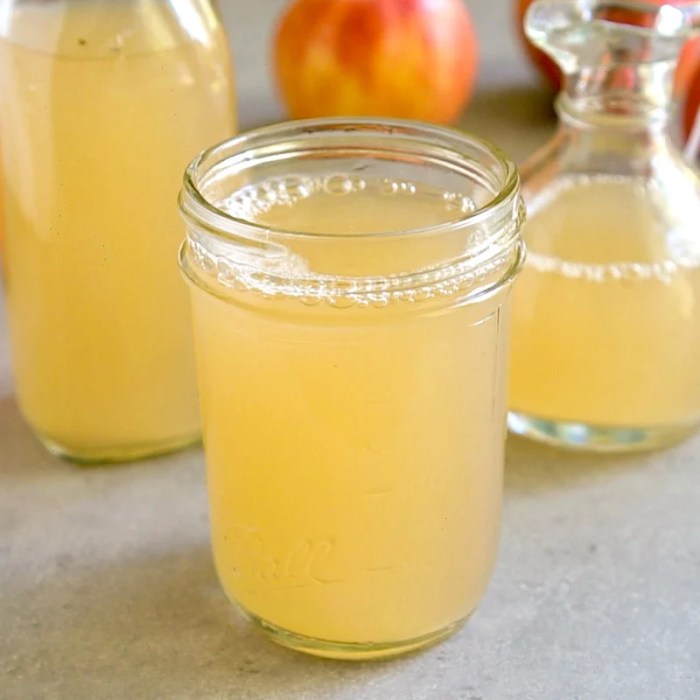Apple Cider Vinegar Barbecue Sauce Recipe
Apple Cider Vinegar Barbecue Sauce: A Flavorful Exploration: Apple Cider Vinegar Barbecue Sauce Recipe

Source: nurturedhomes.com
Apple cider vinegar barbecue sauce recipe – Apple cider vinegar barbecue sauce offers a unique and versatile flavor profile, balancing sweetness, tanginess, and a subtle smoky note. Its adaptability makes it a perfect complement to a wide range of dishes, from ribs and chicken to vegetables and even tofu. While the precise origins are difficult to pinpoint, the use of apple cider vinegar in barbecue sauces likely emerged from the resourceful use of readily available ingredients in various regional American cooking traditions, adding a bright, acidic counterpoint to the richness of meats.
Apple Cider Vinegar Barbecue Sauce: Flavor Profile and Versatility
The characteristic flavor of apple cider vinegar barbecue sauce stems from the interplay of the apple cider vinegar’s sharp tang, the sweetness from added sugars (brown sugar, honey, or maple syrup), and the savory depth provided by spices and other ingredients like Worcestershire sauce or tomato paste. This combination creates a complex and balanced flavor that cuts through the richness of grilled meats and enhances the taste of vegetables.
Its versatility allows it to be used as a marinade, a basting sauce during cooking, or a finishing sauce after grilling or roasting. It can be incorporated into rubs, used as a dipping sauce, or even as an ingredient in other recipes, such as glazes or salad dressings.
Recipe Variations: Sweet, Spicy, and Tangy
Three distinct recipes highlight the versatility of apple cider vinegar barbecue sauce, showcasing sweet, spicy, and tangy variations. The differences lie primarily in the balance of sweet and savory elements and the inclusion of specific spices or peppers to achieve the desired flavor profile.
| Ingredients | Measurements | Instructions | Notes |
|---|---|---|---|
| Sweet Sauce: Apple Cider Vinegar, Brown Sugar, Ketchup, Worcestershire Sauce, Dijon Mustard, Smoked Paprika |
1 cup, ½ cup, 1 cup, ¼ cup, 1 tbsp, 1 tbsp | Combine all ingredients in a saucepan. Simmer over medium heat for 20 minutes, stirring occasionally, until thickened. | Adjust brown sugar for desired sweetness. |
| Spicy Sauce: Apple Cider Vinegar, Brown Sugar, Ketchup, Worcestershire Sauce, Chipotle Peppers in Adobo Sauce, Garlic Powder |
1 cup, ½ cup, 1 cup, ¼ cup, 2 tbsp (finely chopped), 1 tbsp | Combine all ingredients in a saucepan. Simmer over medium heat for 20 minutes, stirring occasionally, until thickened. | Adjust chipotle peppers for desired heat level. |
| Tangy Sauce: Apple Cider Vinegar, Honey, Yellow Mustard, Tomato Paste, Onion Powder, Black Pepper |
1 cup, ½ cup, ¼ cup, ¼ cup, 1 tbsp, ½ tsp | Combine all ingredients in a saucepan. Simmer over medium heat for 15 minutes, stirring occasionally, until thickened. | Honey provides a different sweetness compared to brown sugar. |
The sweet sauce relies on brown sugar for its sweetness, creating a rich and caramelized flavor. The spicy sauce incorporates chipotle peppers in adobo sauce for a smoky heat, while the tangy sauce uses honey and yellow mustard to create a bright and zesty flavor. The level of spiciness can be adjusted by altering the amount of chipotle peppers or other chili ingredients.
For instance, using cayenne pepper would offer a different type of heat than chipotle.
Ingredient Selection and Substitutions
Using high-quality apple cider vinegar is crucial for achieving the best flavor in your barbecue sauce. The acidity and subtle fruity notes of a good quality vinegar significantly impact the overall taste. For those with dietary restrictions, substitutions are possible. Maple syrup or agave nectar can replace honey or brown sugar for vegan options. Gluten-free Worcestershire sauce is readily available for those avoiding gluten.
Different sweeteners, such as brown sugar, honey, or maple syrup, will impart unique flavor profiles; brown sugar offers a molasses-like depth, honey provides a floral sweetness, and maple syrup adds a more robust, earthy note.
Cooking Methods and Techniques
The apple cider vinegar barbecue sauce can be prepared using either a stovetop or slow cooker method. Both methods achieve a delicious result, but the texture and cooking time differ.
Stovetop Method:
- Combine all ingredients in a saucepan.
- Bring to a simmer over medium heat.
- Reduce heat to low and cook, stirring frequently, until the sauce has thickened to your desired consistency (approximately 15-20 minutes).
- Remove from heat and let cool slightly before using.
Slow Cooker Method:
Combine all ingredients in a slow cooker. Cook on low for 4-6 hours or on high for 2-3 hours, until the sauce has thickened. The slow cooker method generally results in a slightly smoother, less intense sauce compared to the stovetop method due to the gentler cooking process and longer cooking time. The stovetop method allows for more immediate control over the thickening process.
To achieve the desired consistency, simmer the sauce until it coats the back of a spoon. For a more intense flavor, you can reduce the sauce for a longer period, allowing more of the liquid to evaporate.
Serving Suggestions and Pairings

Source: wildflourskitchen.com
Apple cider vinegar barbecue sauce is incredibly versatile and pairs well with a wide array of dishes. Its tangy sweetness complements the richness of various meats and adds a delightful zest to vegetables.
| Dish | Sauce Application | Flavor Pairing Notes | Visual Description |
|---|---|---|---|
| Grilled Ribs | Basting and finishing sauce | The acidity cuts through the richness of the ribs, enhancing the smoky flavor. | The sauce creates a glossy, dark reddish-brown glaze that coats the ribs evenly. |
| Roasted Chicken | Marinade and basting sauce | The sauce tenderizes the chicken and adds a sweet and tangy flavor. | The sauce imparts a rich, reddish-brown color to the chicken skin, creating a glistening finish. |
| Grilled Vegetables (e.g., zucchini, bell peppers) | Finishing sauce and dipping sauce | The sauce adds a sweet and tangy counterpoint to the natural sweetness of the vegetables. | The sauce adds a vibrant color and glossy sheen to the vegetables. |
Storage and Shelf Life, Apple cider vinegar barbecue sauce recipe
Proper storage is essential for maintaining the quality and flavor of your homemade apple cider vinegar barbecue sauce. Store the sauce in an airtight container in the refrigerator. Refrigerated, it should last for approximately 1-2 weeks. Unrefrigerated, it will spoil much more quickly and should not be left out at room temperature for more than a few hours. Signs of spoilage include mold growth, a significant change in color or texture, or an off-putting odor.
Discard the sauce if any of these signs are present.
Visual Representation: Sauce Texture and Color

Source: realfoodrealdeals.com
The ideal apple cider vinegar barbecue sauce has a smooth, slightly viscous texture, not too thin and runny, nor overly thick and pasty. The color typically ranges from a deep reddish-brown to a dark amber, depending on the ingredients used. The use of darker ingredients like brown sugar or molasses will result in a darker sauce. When applied to food, the sauce should coat the surface evenly, creating a glossy, appetizing sheen.
On ribs, it creates a sticky, flavorful glaze; on chicken, it imparts a rich, glistening color; and on vegetables, it adds a vibrant hue and glossy finish. The intensity of the color and glossiness can also depend on the amount of sauce applied and the cooking method.
Common Queries
Can I use white vinegar instead of apple cider vinegar?
While possible, it will significantly alter the flavor profile. Apple cider vinegar provides a unique sweetness and complexity that white vinegar lacks. The resulting sauce will be sharper and less nuanced.
How long will the sauce last in the refrigerator?
Properly stored in an airtight container in the refrigerator, your homemade apple cider vinegar barbecue sauce should last for approximately 2-3 weeks.
Can I freeze this sauce?
Yes, you can freeze the sauce for longer storage. Allow it to thaw completely in the refrigerator before using.
What are some signs that the sauce has gone bad?
Signs of spoilage include mold growth, a significant change in color or texture (becoming unusually thin or thick), and an off-putting odor.





















